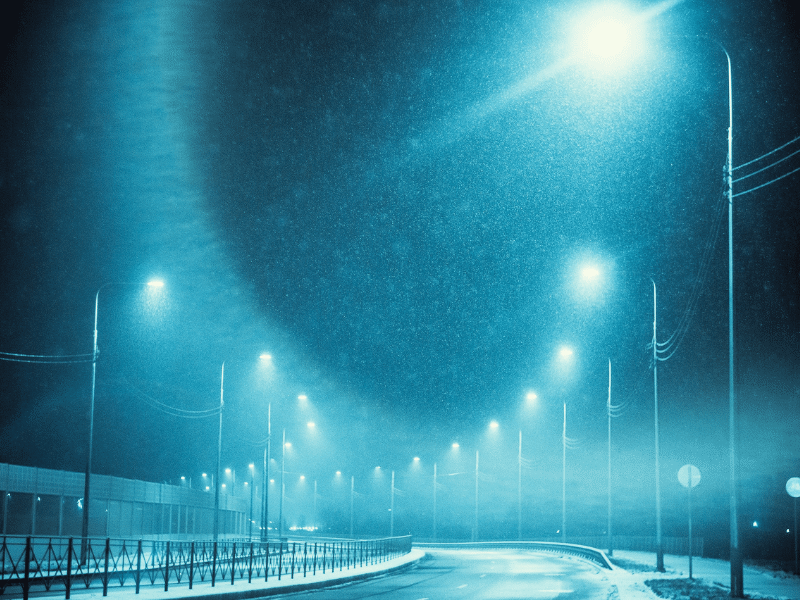Exterior lighting pushes back the darkness and can make the otherwise intimidating nighttime environment more welcoming and functional. But lighting can also impact our well-being. The extent of that impact is currently under debate between the American Medical Association (AMA) and Illuminating Engineering Society (IES). Despite conflicting viewpoints, there are steps you can take to complete healthy and practical exterior lighting projects.
With the advent of new lighting technologies, our exterior lighting environment undergoes generational changes. Incandescent gave way to low pressure sodium, which gave way to high pressure sodium and metal halides, and in turn have rapidly given way to light emitting diodes (LEDs). This most recent rapid shift in technology has been accompanied by new physiological research about the human eye. With both new technologies and new research, there are corners of the lighting community rethinking their approaches to exterior lighting.
In the Summer of 2016, the American Medical Association’s Council on Science and Public Health released a report (CSAPH Report 2-A-16) outlining their concerns with exterior lighting. Their conclusions and recommendations were relatively moderate:
1. That our American Medical Association support the proper conversion to community-based Light Emitting Diode (LED) lighting, which reduces energy consumption and decreases the use of fossil fuels. (New HOD Policy)
2. That our AMA encourage minimizing and controlling blue-rich environmental lighting by using the lowest emission of blue light possible to reduce glare. (New HOD Policy)
3. That our AMA encourage the use of 3000K or lower lighting for outdoor installations such as roadways. All LED lighting should be properly shielded to minimize glare and detrimental human and environmental effects, and consideration should be given to utilize the ability of LED lighting to be dimmed for off-peak time periods. (New HOD Policy)
These seemingly modest requests were interpreted by various news outlets. As a result, once modest proposals were warped by a mixture of misunderstandings, poor technical translations, and provocative headlines chosen to increase clicks.
What do the AMA recommendations really mean for outdoor lighting?
To understand the dilemma posed by the AMA’s recommendations, we first need to understand a little bit of physiology and a little bit of the LED technology.
Human Physiology
Recent research by a variety of institutions and practitioners focuses on a cluster of light detecting cells in the bottom of the human eye. Vision is accomplished via cones (cell photoreceptors tuned to red, green, and blue vision) and rods (cell photoreceptors sensitive to low light, brightness and darkness). These newly researched cells do not communicate with the vision centers of the brain, but they do communicate with the hypothalamus, the hormone center of the brain. These new cells are (somewhat unsurprisingly) light-sensitive, thus, they have the name: intrinsically photosensitive retinal ganglion cells (ipRGC).
The ipRGCs contribute to two important physiological functions. The first is the pupil constriction we experience when we step out into bright light. The other function is the synaptic communication with the hypothalamus – the home of our circadian clock. These cells are most sensitive to light measured at approximately 480 nm. The strength of the current lighting dose (versus the last sleep-wake cycle maximum) and the duration of the lighting dose function into the hypothalamus’ response to the ipRGC stimulus.
LED Technology
Light emitting diodes (LEDs) provide light via a mechanism called electroluminescence. Depending on the types of materials in the LED chip, it may shed light that is blue, violet, orange, green, or some other color. Most commercial LED products use a blue light-emitting Gallium Nitride (GaN) chip with a phosphor that converts much of the blue light to other wavelengths, creating white light.
When LED chips are tested using the industry-standard LM-79 test, the spectral content is measured and the result is the spectral power distribution (SPD). This is the only way to evaluate the spectral content of a light source. From the spectral power distribution, we generate a variety of other metrics, including the correlated color temperature (CCT). Correlated color temperature is a scale that matches the color appearance of a light source to the appearance of a hypothetical material heated to a specific temperature. Because the color appearance is correlated to temperature, the CCT is measured in kelvin and denoted with a capital letter K.
So what impact does LED lighting have on us?
The recent proliferation of inexpensive exterior lighting has shifted our night time environment from the generally orange haze of 2,200K high pressure sodium to the sterile blue of 4,000K to 5,000K LED. Exposure to these wavelengths for an extended period can disrupt the sleep wake cycle and make duration and depth of healthy, regenerative sleep difficult to attain. This explains the AMA’s preference for 3,000K light sources and their distaste for ‘blue’ light.
The Illuminating Engineering Society’s Response
After reviewing the AMA’s response and the mild new frenzy about the topic, the Illuminating Engineering Society (IES) was concerned that the AMA was providing technical guidance that failed to account for good lighting design and was unnecessarily alarming to public – including building owners, operators, and potential lighting clients. Their response, with the support of the International Association of Lighting Designers (IALD), position statement PS-09-17, takes aim at the second and third conclusions of the AMA statement (blue-light glare and 3,000K light sources).
Glare and blue light are not synonymous
We experience glare in two broad categories – disabling glare and discomfort glare. Disabling glare prevents a viewer from doing whatever it is they need to do. I’m sure we’ve all had to nurse our cellphone battery and turned down the brightness of the screen to eek out a few more minutes of battery life. When under a bright light source (a direct luminaire or the sky) the screen reflects the light source back to our eye and we can’t see the screen very well. This prevents us from accomplishing our task. Disabling glare is controlled by reducing the brightness of the bright source (e.g. blocking the source with your body), deflecting the blocking light-rays (tilting your phone) or increasing the surrounding brightness (turning up the screen brightness). In an exterior lighting application, this could be a problem on a rainy night, where a pool of water catches the streetlight and obscures a pothole. Similarly, a high-angle streetlight distribution may cause a driver to squint and reduce perception.
Discomfort glare is an inconvenience – it may be annoying (the lighting equivalent of a rock in your shoe) but the visual task is not interrupted. Most streetlighting retrofits done purely out of energy-saving motivations have lighting systems that fall into this category. The lighting isn’t exactly pleasant, but the lighting is functional.
Based on these definitions, a savvy consumer may ask “where does blue light come in?” It doesn’t, and therein lies the IES’ and IALD’s problem with the AMA point 2. Blue light is not directly responsible for glare – bad lighting design or inappropriate luminaire application is responsible for glare.
Color temperature is a poor metric for measuring color sensitivity
The IES correctly notes in their response that color temperature does not predict exposure to wavelengths that could affect the circadian rhythm.
Using the IES’ TM-30 calculator, I retrieved a few spectral power distributions to give us something to consider as an example.
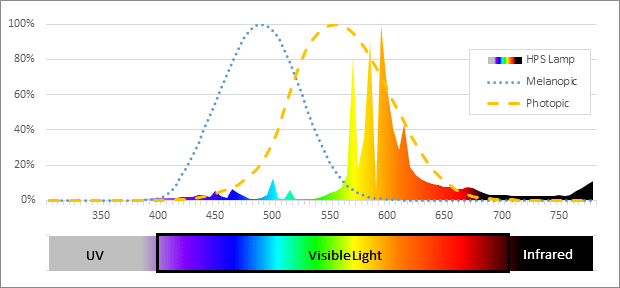
Spectral Power Distribution High Pressure Sodium (HPS) Lamp
The chart above shows a high-pressure sodium lamp. The blue dotted line is the melanopic relative sensitivity curve (for the ipRGCs), while the yellow dashed line is the photopic (color vision attributed to cone cells) relative sensitivity curve.
If we were to switch this HPS lamp with a 3,100K LED lamp, we’d get a curve like the one that follows below. Of course, every LED chip will have a slightly different wave length, although blue-pump phosphor coated chips have a similar pattern – a blue spike with a wide green/yellow/orange hump.
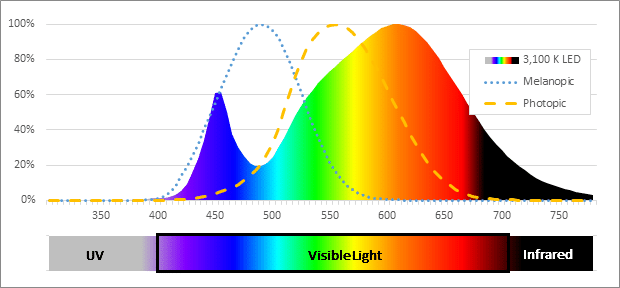
Spectral Power Distribution 3,100 K LED Lamp
We can put the above curve next to a 5,200K LED to see the difference. A bigger blue spike and a shallower green/yellow/orange hump.
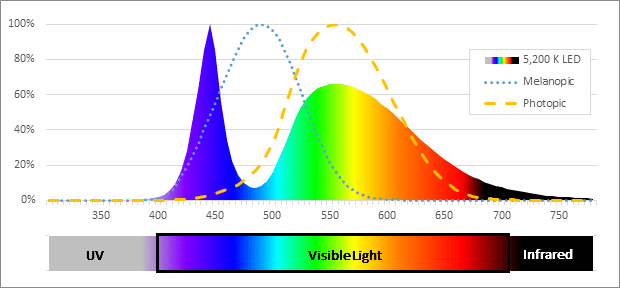
Spectral Power Distribution 5,200 K LED Lamp
Despite having a CCT of 5,200 K, the light produced by the second LED has less sleep-disrupting effect at night than the substantially warmer 3,100 K LED (approximately 12% less). This is primarily because while the blue spike is much greater in the 5,200 K chip, the trough between the blue and green is much lower and it is these wavelengths that the ipRGC is most sensitive to.
Making Good Decisions in Absence of Industry Consensus
In the AMA response to the IES position statement, the American Medical Association lamented the lack of actionable recommendations that the layperson could understand. I respectfully disagree – there is plenty of good lighting design practices that will mitigate many of those problems.
1. Know Your Needs
Identify what is important and document how each issue will be addressed. Not every criterion merits the same attention, so feel free to employ a hierarchy when composing your solution. Some topics to consider include:
- What is my motivation?
- (Energy, maintenance, lighting quality, emissions, other?)
- What standards apply to my project?
- (Energy code(s), local ordinances, safety requirements, LEED light trespass, Dark-Sky targets, environmental concerns, utility incentives, campus plans or architectural standards)
- What constraints are there on the project?
- (Budget, no new poles, buy-local, limit maintenance stock, field-replaceable components, controllability, similar form-factors)
- How will you judge the project’s success?
- (RP-08-2014 luminance targets, energy saved, life-cycle cost, increased sales at night, LEED points)
- Who is on the team?
- (In-house team members, consultants, designers, engineers, contractors, luminaire representatives, distributors, fire marshal, etc.)
2. Engage Your Stakeholders
A successful lighting project builds a coalition of people with a stake in solving the problem. Most communities choose to go about these projects in an environment that excludes the public and private stakeholders who are most directly affected by the lighting system. Mocking up proposed lighting solutions in key areas can prevent costly mistakes (like happened in Davis, CA) and reveal problems with overall color consistency (as was noted in Rome).
3. Use Good Design Practices
Good lighting design practices don’t stop at the door of our buildings – they apply everywhere we decide to install electric lighting. Here are some tips that we use when scoping our projects:
Get a lighting professional on the team
Lighting designers and lighting consultants offer technical expertise that can help avoid costly pitfalls and can recoup their costs in greater productivity, satisfaction, reduced material costs, and greater energy performance. A consultant may push project teams to ask questions that on their surface seem of minor importance, but ensure that all the stakeholder needs are addressed. A good lighting professional will help steer a project around costly delays, questionable product quality, and poor lighting performance. Lighting consultants come in many flavors, so review their qualifications carefully to make sure you’ve teamed up with an ally that shares your perspective.
Provide only the electric light you need
Select illuminance (or luminance for roadways) criteria that make sense. Refer to industry recommended practices as a starting point and customize where necessary. Use calculation tools (e.g. AGi32 or Visual) to refine your approach.
Use controls to further manage light-output and energy consumption
New control options in streetlighting allow customers to vary the output of their exterior lighting system based on vacancy or time of day schedules. Using these features for your project maximizes energy savings, minimizes light pollution in the form of unnecessary lighting, and helps prolong the life of your LED products. Furthermore, networked exterior lighting may also provide more uniform output over the life of the product by dimming the light initially and gradually increasing output as the product ages (thereby compensating for lumen maintenance and/or dirt depreciation).
Manage the lighting distribution
The older exterior lighting NEMA distribution classifications when combined with BUG ratings make for incredibly valuable tools for the lighting specifier or designer. Be mindful of what you are lighting and select lighting distributions that doesn’t spread into unintended areas. Consider the following picture as an example:
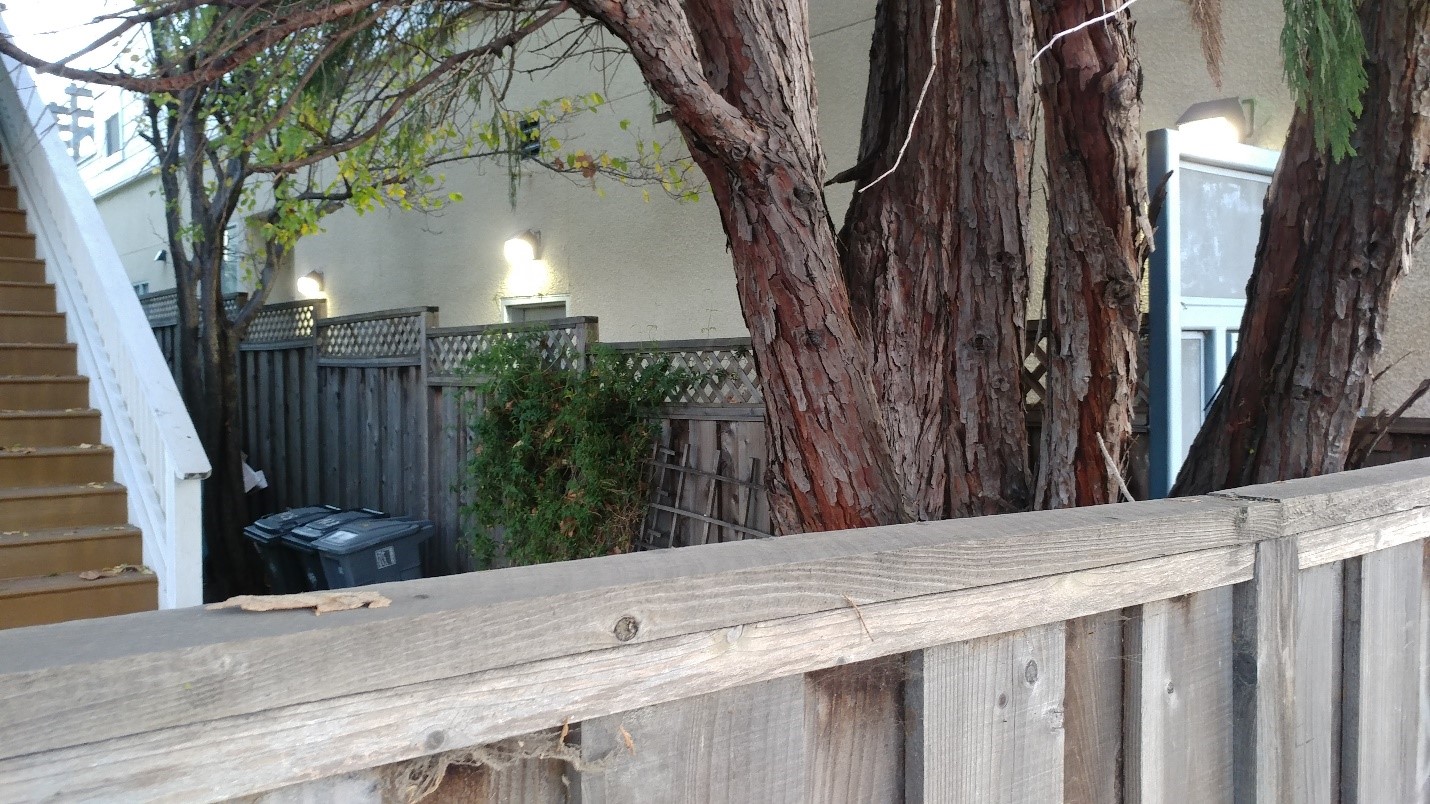
Poor and Inefficient Exterior Lighting Example
The building owner has a narrow (~30 inch) walkway around their building, adjacent to a residence with a fence. They installed partial cut-off wall packs with a mounting height higher than the fence. A good portion of this lighting will now intrude on the adjacent residence. Type 2 wall packs with a full cut-off would have performed perfectly for the building owner (lighting the walkway), limited light trespass, and resulted in less energy consumption.
In residential areas, consider specifying luminaires with a Backlight rating of 1 or less and installing house-side shields to ensure no light trespasses into adjacent residences. Glare control is another vital consideration, both for neighbors across the street or adjacent to buildings with wall packs. Avoid uplight all together, except in applications where uplighting is required to accomplish the lighting goals (e.g. façade or porte cochere lighting).
Be Mindful of Health Impacts with Exterior Lighting & Design Accordingly
While the precise metrics for healthy lighting is still to be determined, the science is clear enough that we can take practical steps when dealing with exterior lighting. Recent advances in LED chip design have reduced the cost of lumen packages with lower melanopic content (generally, those with lower CCTs, but as we discussed above – not reliably in every case).
Use low melanopic light sources in:
- Exterior Areas Catering to Customers at Night: Outside dining areas and pedestrian malls that push back the shroud of night to encourage their guests to linger and enjoy themselves are a great application for low melanopic light sources. Eventually these guests will go home and want to sleep.
- Residential areas: People sleep nearby and light trespass will generally be an issue regardless of the steps we take to limit it. Reducing the melanopic wavelengths in our residential light sources will yield benefits to the adjacent residences.
- Trails, preserves, zoos, and parks: Wildlife is doubly affected by blue light at night. If the local environment and the well-being of nearby critters is a concern – limiting melanopic light can help maintain the function of the local ecosystem.
- Eldercare facilities: There is wonderful research that suggests that controlling light exposure in eldercare facilities can dramatically help with dementia. Thus, night exposure to light sources with high melanopic content can reverse healthy sleeping that minimizes dementia symptoms.
Keep an eye out for continuing research in health associated with exterior lighting. There are many designers and researchers investigating how to best apply what we know. New information is certain to change design practices and the lighting industry in the next decade.
Like this post? Share it on LinkedIn.

